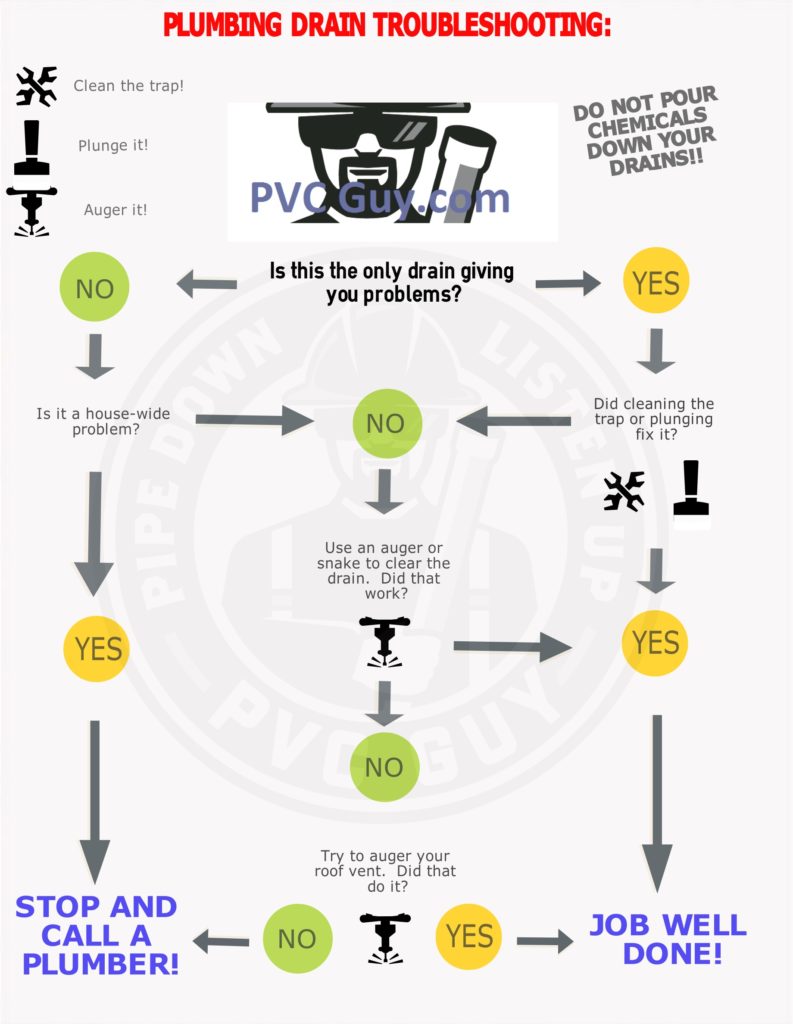The Step-By-Step Process To Tackle Slow Drains
Slow drains are an inevitable nuisance that every home owner will eventually face. Even if you are a renter or live in an apartment, most of these problems you can fix yourself without needing a professional plumber. Below you will find the best way to fix slow drains and troubleshoot the problem.
If you were to ask most homeowners or the average Joe what you need to do with a slow draining toilet, the vast majority of them will tell you to pour some variant of Drano or Liquid Plumber down to clear the clog.
I am here to tell you DO NOT POUR ANY CHEMICALS DOWN YOUR DRAIN!!
You are wasting your money and possibly causing more harm than good. The best way to fix slow drains for good is to follow the steps below and to use this infographic to determine what steps you need to take.
First, you need to assess your situation. Is it the only slow drain in the house? Drains typically share sewer and vent lines, so it gives you an idea of how far aware your clog might be located.
If so, you are in major luck. There’s a very good chance that you will be able to simply fix this problem by either plunging the drain or cleaning the P-trap. Over time, hair, crud and other nastiness builds up in your pipes occasionally requiring a clean out.
Your best case scenario is that your plunger clears the clog in short order. Most people don’t realize that if you can plug the overflow drains in sinks and tubs, you can use a plunger there too.
If you have a wine cork laying around, whittle it down to the size you need for sinks, or use a wet rag. For tubs, remove the overflow drain cover and plug it with a wet rag.
To treat a slow drain, the first step is plunging. If you plunge and it clears the drain you are in luck. If you plunge and water is going down the drain and then back up, it probably means the clog is further down the line and cleaning the P-trap will not be effective. If you just aren’t able to get water to move down the drain at all, try cleaning anything you can from the drain like hair or soap scum and then unscrew your P-trap, if you have access to it.
Many times, if the clog is cause by heavier objects like gypsum or sand it can settle in the P-trap and build up over time. It’s always a good idea to clean your P-traps every 6 months to a year anyways. You won’t be able to access toilet P-traps, so you can try using a closet auger, if you have one. (They are a great investment for homeowners.)
If the P-trap cleaning and plunging did not work or you have multiple drains in your bathroom or connected rooms are slow draining, then you are likely to have a problem in one of two areas. Either you have a clog somewhere further down the line or you could possibly have a ventilation issue.
Next step is to try using an auger or “pipe snake,” which will clear most clogs you will find in your sewage line. Run it down the slow drain and see if that helps.
Sometimes, though not commonly, birds or other creatures can build nests in your bathroom ventilation system. If not enough airflow can reach your line, then it can create a siphon effect which would cause gravity fed lines to stop or drain slowly. I always hate suggesting to DIYers to get on their roofs, but if your roof slope is flatter and you are comfortable doing so, climb on up and run your auger through the offending pipe vent.
If none of the above steps have solved your problem, then you have one more option to try if you are comfortable doing so. You need to find your sewer line clean-out and run your auger through to see if you can find the blockage. You need to be very careful not to force anything – if it is a blockage you can clear, it shouldn’t take much force to dislodge.
Unfortunately, there are instances where you just can’t fix the problem yourself. If nothing has worked and you have a septic tank, you may need to have it drained. If you are on a municipal sewer line or septic tank, you could have a collapsed line or tree roots penetrating the line which will require the help of a professional. Before you call the reinforcements, try to take care of the drain yourself.
I hate seeing people call plumbers out, only to have them reach into bathtub drains and pull a wad of hair out for $100+. It happens more often than you would think. And remember, those chemicals you pour down the drain might as well be dollars flushing down the toilet making your situation even worse.
Leave a Reply